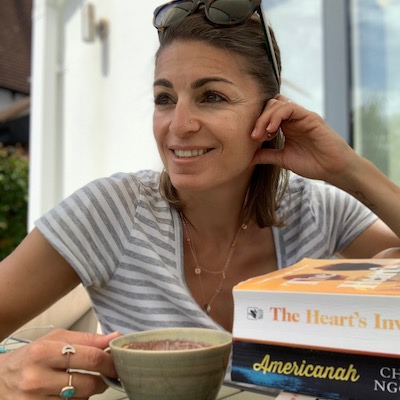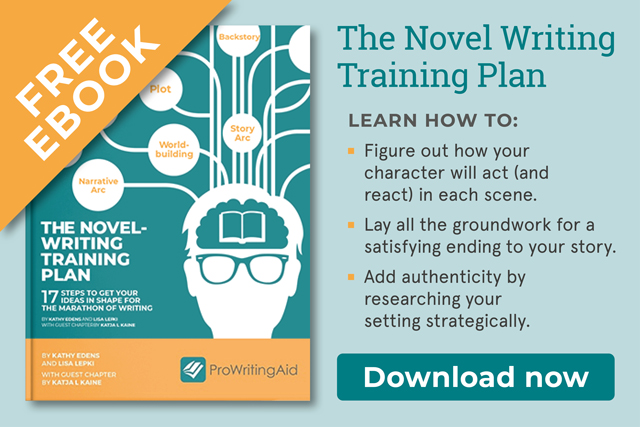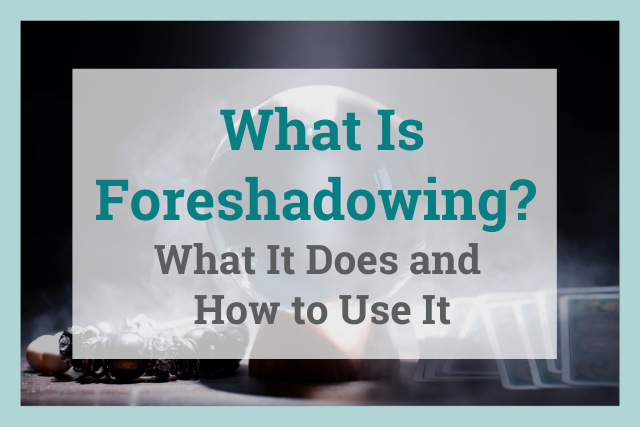
Do you want to increase suspense in your writing? Build anticipation? Create a sense of foreboding? Provide some clues for your reader about what’s yet to come? Then foreshadowing is a literary device that can help you achieve just that.
What Is Foreshadowing?
Think of foreshadowing as leaving a trail of literary breadcrumbs. Your readers, if attentive, can collect them along the way, giving them a sense of “Ah, I knew that was coming!” when they reach the climax of your story.
As a writer, you want your reader to be invested in your tale, with your characters. By using foreshadowing as a narrative technique, you help to prepare them emotionally for what’s to come.
Whether that be a death, an accident, a strange encounter—most readers appreciate a bit of a heads-up before your big shocker.
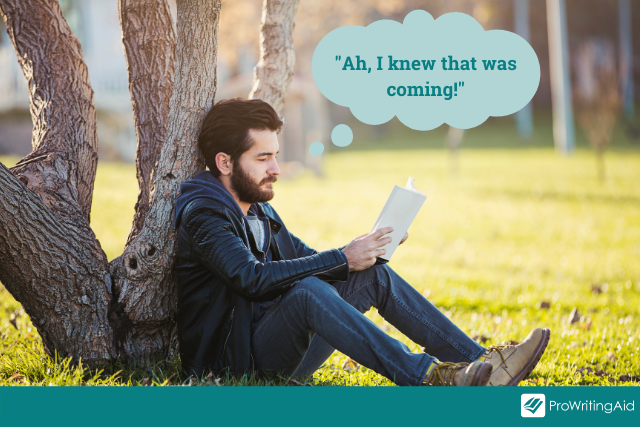
And yet foreshadowing doesn’t necessarily have to prepare your reader for impending battle or doom. It is a popular literary device used across all genres, from crime, thriller, and mystery writing to romance, historical, and literary fiction. It can also be used in non-fiction writing.
Foreshadowing can help you make strange events appear more credible. So you’re not only helping your reader by increasing their anticipation, but you’re also helping yourself by making whatever event you have chosen to include more plausible for them to accept.
The Two Types of Foreshadowing
How much or how little you want your reader to be able to guess at is entirely up to you. Different types of foreshadowing can provide varying levels of insight into your story.
Some authors make it very obvious when they want you to become aware of something. Think Harry Potter’s aching scar—an indication of imminent confrontation with Voldemort. Other writers give only the most subtle hint at what’s yet to come.
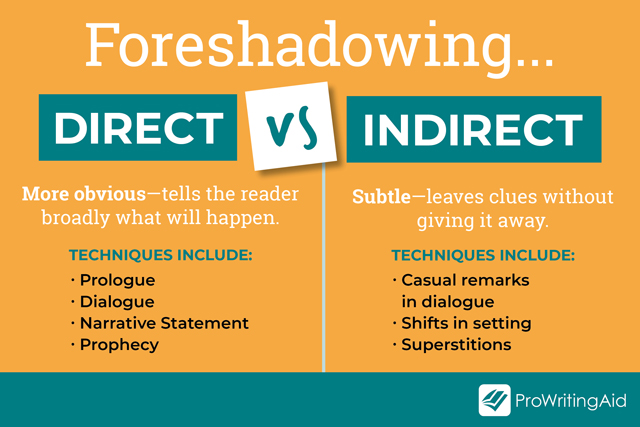
Direct Foreshadowing
Direct foreshadowing is simply the most obvious way for an author to prepare the reader for an upcoming event in the narrative. This can be done through a prologue, a dialogue, a statement by the narrator, or through a prophecy.
One of the most famous literary examples of direct foreshadowing can be found in Shakespeare’s Macbeth.
The three witches make three prophecies; after the first comes true—that Macbeth will become a thane—the reader can expect the next two prophecies to become true as well, those predicting that Macbeth himself will become king and that Banquo’s sons will one day be kings too.
The witches’ appearances throughout the play lend credence to Shakespeare’s foreshadowing and create a sense of anticipation and narrative tension.

Indirect Foreshadowing
Indirect foreshadowing can take many shapes and forms. It can be purveyed by noting small changes in the environment, choosing a particular setting, including conversational remarks, or even mythical omens or superstitious beliefs.
In Bianca Marais’ Hum If You Don’t Know the Words, the protagonist Beauty is searching for her missing daughter. Having been anonymously warned to back off her search, Beauty starts noticing owls appearing around her in the evenings, at dusk to be precise.
She counts these appearances. After the second sighting, she wonders what the appearance of a third might indicate. Earlier in the text another protagonist, Robin, noted that bad things always happen in threes. What is the author trying to tell us here? Might tragedy strike after a third sighting?
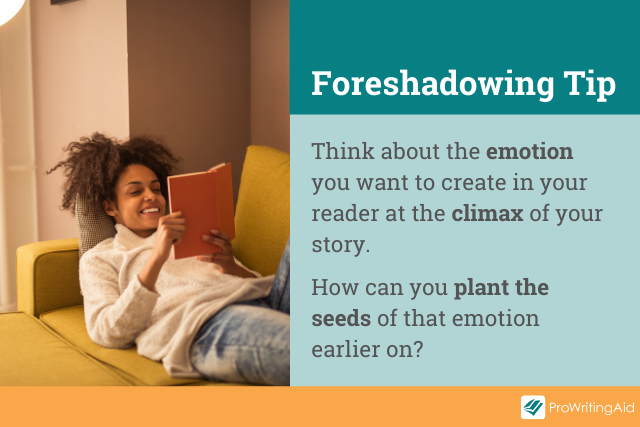
Commonly Confused Techniques
The following are some literary devices that are commonly mistaken for foreshadowing. There is absolutely nothing wrong with using these in your writing. If anything, they can add context and suspense to your narration. Just be aware that they are different from foreshadowing.
Chekhov’s Gun
The author Anton Chekhov, when discussing the craft of writing, reportedly said that if there is a gun on the wall in Act 1, it must fire by the end of the play. In other words, no irrelevant elements should be placed in a text.
This simply means that if you choose to include and describe, say, a vase of flowers on the sideboard of your protagonist’s living room, this vase should play some type of role in your narration later on. Whether you use it to bash over an intruder’s head, or it gets toppled during an argument, or knocked over in a clumsy moment, it should reappear, otherwise don’t bother mentioning it in the first place.
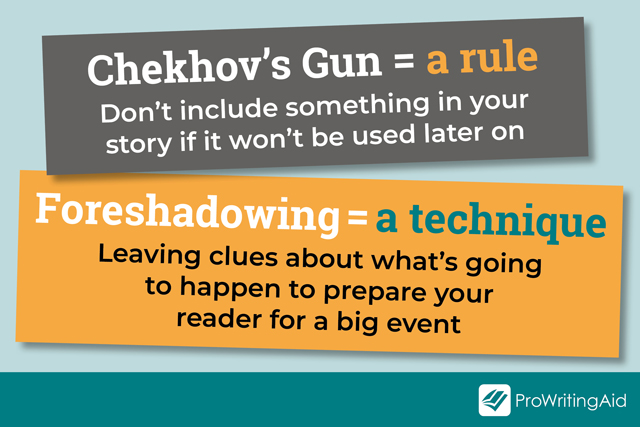
Flashbacks and Flash-Forwards
Flashbacks and flash-forwards are scenes that interrupt the flow of the narrative to recount something that has happened in the past or to glimpse what will happen in the future.
Unlike foreshadowing, which is subtle and creates anticipation by dropping hints, a flashback or flash-forward increases suspense by making the reader question the how or why rather than the what—as that’s information they’ve already received.
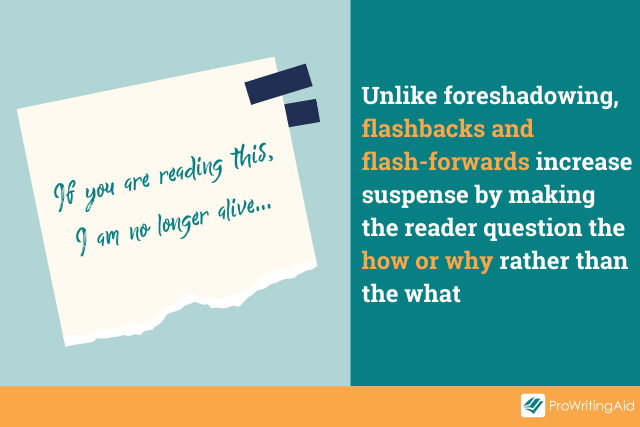
Let’s take a look at an example.
The first chapter of C.L. Taylor’s thriller Sleep begins with the following: “If you’re reading this then I am no longer alive.”
The letter-writer then proceeds to give a list of names, presumably suspects, and notes the details of other people that can be contacted to provide further context. The second chapter then takes place three months earlier.
We already know that someone is going to die, we now know that the story will take place over the course of three months, and we know how many main players there will be. But the why and how are left unanswered. And thus our journey of discovery begins.
Red Herrings
A red herring is not foreshadowing.
Instead, this technique is used to distract or mislead the reader. Both Sir Arthur Conan Doyle and Agatha Christie were infamous for their use of red herrings, planting clues in their stories that had nothing to do with the actual mystery to befuddle and confound their readers.
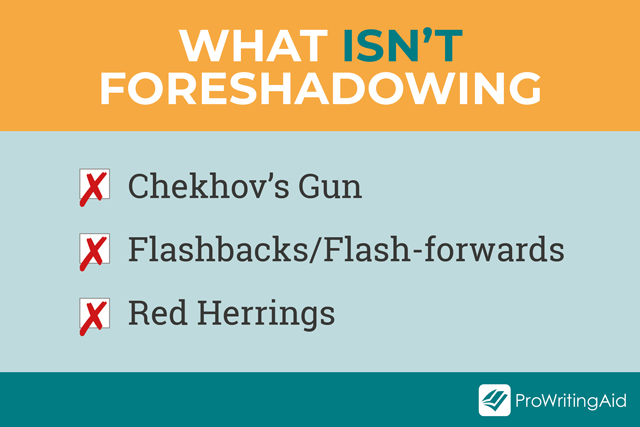
Include Clues in Your Title
A simple and effective way of foreshadowing the plot of a novel and creating anticipation in your reader is by including it in the title of the book or a chapter. Look at some of the following titles and take a guess at what the book might be about:
- The 100-Year-Old Man Who Climbed Out the Window and Disappeared
- The Brief and Wondrous Life of Oscar Wao
- The Other Black Girl
- My Sister the Serial Killer
- Murder on the Orient Express
- Eight Perfect Murders
- Death on the Nile
- The Return of Sherlock Holmes
- The Final Revival of Opal and Nev
- The Seven Husbands of Evelyn Hugo
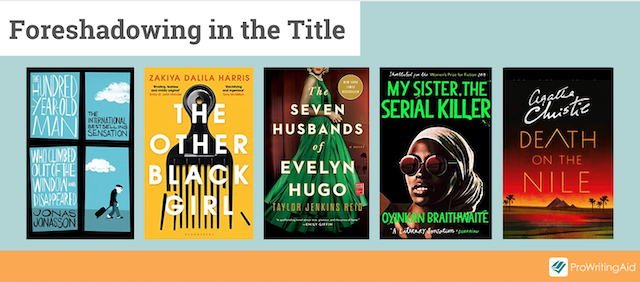
How to Foreshadow in Your Writing
Now that you understand what exactly foreshadowing entails and why you should use it in your writing—remember, we want your readers to feel a sense of anticipation and suspense but also prepare them emotionally for what’s about to happen—what’s the best way to go about it?
Take Inspiration from the Screen
An easy way to think of foreshadowing is to examine how the technique is used in movies and TV shows. It is relatively easy to create an emotional response in viewers with the tools available on screen.
Consider the famous shark scene in Jaws. Before the actual shark attack takes place, we have Chief Brody looking anxiously out to sea. There’s a woman who starts screaming in the water, although it turns out that she’s just fooling around with her boyfriend. Next, that music starts up.
A shot of the murky water. Children’s feet churning up the sand. All this takes place in the couple of minutes before the actual attack, increasing our sense of anticipation and, in this case, giving us a sense of imminent danger—despite the fact that nothing has actually happened yet. We feel prepared for what’s coming next.

As authors we don’t have the same tools available to us to set a scene and create a certain atmosphere as screenwriters do, but there are plenty of literary techniques to help create an equally powerful scene of foreshadowing.
Foreshadowing Through Pacing
Think of that Jaws example again. Things start to happen very quickly just before the shark strikes. This is something we can mirror in our writing. Set your reader on edge by describing several actions or events in quick sequence so that they’re left feeling that something is going to happen—they’re just not sure what yet.
Pacing is important throughout your novel. ProWritingAid’s Pacing Report will show you where you’ve written several slower paced paragraphs in a row so you can vary them with some action or dialogue.

Check the pacing around your foreshadowing—are you varying your slower paced, descriptive foreshadowing with action or event based clues?
Foreshadowing Through Dialogue and Reactions
Let’s stick to the beach for a quick and easy illustration of this. Here we have Pete, Kay, and their two boys, out for a day on the beach.
The boys are playing in the sand while Kay is searching through their bags. She turns to Pete and tells him that she can’t find the boys’ armbands.
“Are you sure you packed them, Pete? I can’t find them anywhere,” she tells him anxiously.
She’s worried that despite the children’s recent swimming lessons, they shouldn’t be allowed in the water without their flotation aids.
“I don’t like the idea of them going in without their armbands. There are strong currents here.”
Pete wants to reassure his wife and tells her that the boys will be fine. The water is only shallow and they’ll keep a good eye on them. The boys have made some friends, a couple of years older, with whom they’re having a romp in the water.
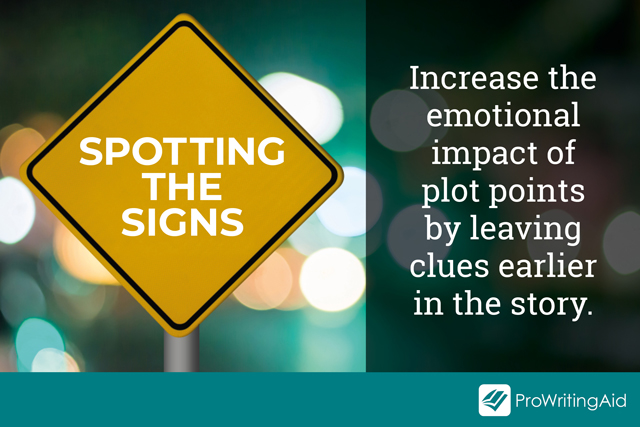
At first, the boys’ parents watch their children attentively, calling out to them to be careful and not to go in too deeply, but soon they get distracted—Pete by looking at his phone, Kay because someone on the neighboring towel has started up a conversation with her.
What do you think might happen next? There are enough clues here to foreshadow something unexpected taking place. The focus on the missing armbands and admonitions not to go in too deeply combined with the wild playing with older friends might indicate that one of the children could be involved in a near-drowning accident.
We don’t know, but we’re getting a sense... Did you spot the signs?
Foreshadowing Through Settings and Symbolism
You can also create suspense in a subtle manner through settings and symbolism. One obvious and popular technique is to use the weather to foreshadow events.
A blue sky suddenly going dark, storm clouds moving in, the air feeling close and humid, thunder and lightning—these all help to build a sense of foreboding that something is about to change.
Equally, a sudden blue sky and emerging sunshine, birds twittering, and butterflies fluttering about are also helpful to set the scene and point towards a potentially positive change about to take place.
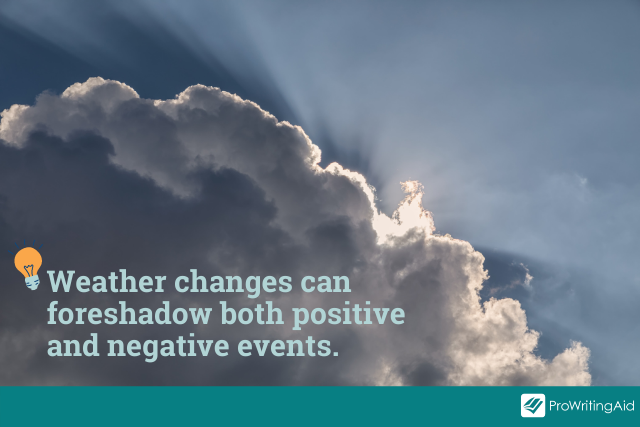
Let’s try another example.
Here’s Rachel, hurrying home. It’s dusk and the sky is quickly clouding over. She wonders aloud whether it’s about to start raining.
When she pulls out her phone to check the weather forecast, she realizes that her battery is dead. As she stumbles along the path, cursing herself for wearing such impractical shoes, she passes a cemetery on her left and notices a black cat that is sitting by the gate, seemingly keeping guard.
As she looks up, she discovers a red scarf that has become stuck in the branches of a nearby tree, slowly floating on the breeze.
We don’t know what’s going to happen to Rachel on her way home, but we sure don’t have a good feeling about it, do we?
Recap: Foreshadowing Techniques and Examples
That’s an overview of the elements and techniques you can use to help you foreshadow certain events in your writing.
Weather and dialogue as well as symbolism and setting can help build anticipation and create a sense of foreboding in these paragraphs. Readers can pick up on these and come to the conclusion that yes, something is probably about to develop.
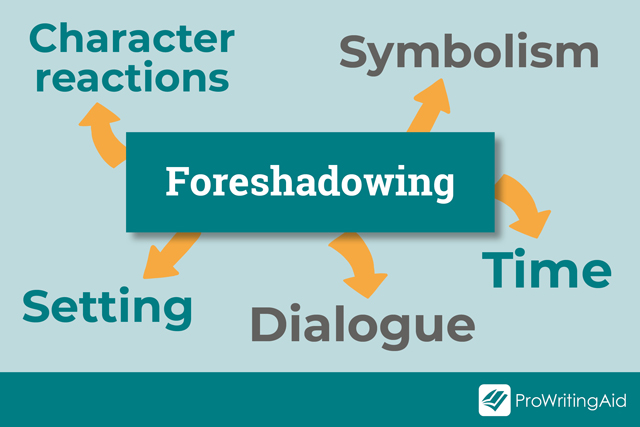
A quick recap from our two examples above:
Character reactions:
- apprehension (Kay)
- distraction (Kay & Pete)
- haste (Rachel)
- self-doubt (Rachel)
Dialogue (external or internal)
- “I don’t like the idea of…”
- Rachel cursing herself
Setting
- water/dangerous currents
- cemetery
- deserted path
Symbolism
- black cats (evil omen)
- the color red
- a dead phone
Time
- dusk
Also keep in mind that the hints you drop do not necessarily mean that something has to happen right away. You could casually be leaving clues throughout the entire length of your narration, leading up to the grand finale of your book. Whichever tactic you choose to employ, make sure to tie up those loose ends to avoid confusing or misleading your readers.
So, that’s foreshadowing for you. Now off you go, leave those literary breadcrumbs to build that dramatic tension, increase anticipation, and keep your readers hooked.
And remember, the more subtle your hints, the greater the satisfaction when they can—or can’t—figure out what’s about to happen.
